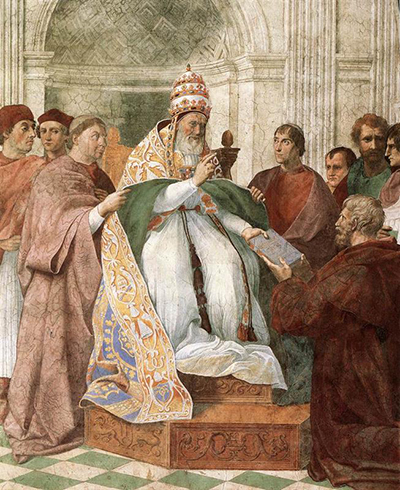Towards the end of Raphael’s short career, he created a number of works for the Pope at the time, Pope Julius II
One of those was a fresco completed in 1511 titled Gregory IX Approving the Decretals. It can be seen in the Stanza della Segnatura in the Vatican.
Fresco of Gregory IX Approving the Decretals - In 1511 Raphael created the fresco showing the 13th-century scene of Pope Gregory IX Approving the Decretals. The fresco shows the power of the Roman Catholic Church. By the year 1230, many different collections were home to canon law. Pope Gregory gave St. Raymond de Penafort the task of sorting it all into a single collection of canon law.
In the scene, we see Pope Gregory accepting and reviewing the Decretals received from St. Raymond de Penafort, his chaplain and confessor. This new single collection became known as the Liber extra. Pope Gregory ruled that only the new collection should be recognised and used at universities.
In the fresco, Raphael opted to include figures from his era rather than of the time of Pope Gregory. He uses a portrait of his patron, Pope Julius II, in place of Pope Gregory IX. Of the other figures in the scene, two of the cardinals beside the pope are that of Giovanni de' Medici and Alessandro Farnese. They were later to become Pope’s Leo X and Paul III.
Raphael is just one of a number of famous artists to have been tasked with painting portraits of key figures, be it Popes, Kings, Queens or other noblemen or women. Hans Holbein for example is well known for his paintings of Henry VIII. Charles VI and Odette de Champdivers by Eugene Delacroix, Charles IV of Spain and His Family by Francisco de Goya, Portrait of Pope Innocent X by Diego Velazquez and Anna of Austria by Peter Paul Rubens are also all worthy of note.
Raphael's Roman Period - In the final years of Raphael's short life, Pope Julius II invited him to come to Rome. It was to be a time that would become known as Raphael’s Roman period. The Pope commissioned Raphael to paint a number of frescoes in his private rooms in the Vatican.
The first room completed was the Stanza della Segnatura (Room of Signatures) in 1511. Each wall in the room deals with a specific theme.
The south wall of the room deals with Jurisprudence. It was on this wall that Raphael created two medium frescos. The fresco on the left-hand side of the wall shows the Emperor Justinian handing the Pandects to Trebonianus.
It represents the civil law of the secular state. The second fresco on the right is the scene of Pope Gregory IX Approving the Decretals. It deals with the issue of canon law of the church. Some say that the frescoes in the Stanza della Segnatura were Raphael's greatest works.




